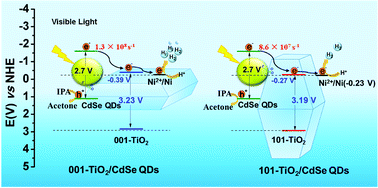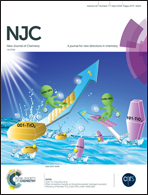Effect of electron transfer on the photocatalytic hydrogen evolution efficiency of faceted TiO2/CdSe QDs under visible light†
Abstract
Quantum dot (QD)/TiO2 composites are widely used materials in the field of photocatalysis. However, the influence of different exposed facets of TiO2 in composites on photocatalytic hydrogen evolution is rarely reported. In this work, CdSe QD–TiO2 composites with dominant {001} or {101} faceted anatase were synthesized and specifically characterized using X-ray powder diffraction, transmission electron microscopy and X-ray photoelectron spectroscopy. Photocatalytic hydrogen evolution tests reveal that {001}-TiO2/CdSe QDs exhibit a 213.1- and 9.0-fold increase in photocatalytic activity compared to {001}-TiO2 and CdSe QDs, respectively. Notably, the photocatalytic activity of {001}-TiO2/CdSe QDs is 2.2 times higher than that of {101}-TiO2/CdSe QDs. Based on the results from UV-Vis diffuse reflectance spectroscopy, Brunauer–Emmett–Teller surface area testing, Mott–Schottky testing and steady-state and time-resolved emission spectroscopy, the main reason for enhanced photocatalytic activity is the faster electron transfer from CdSe QDs to {001}-TiO2 compared with to {101}-TiO2. This research on tailored facets in QD/TiO2 composites provides primary insights for the design of effective photocatalysts.



 Please wait while we load your content...
Please wait while we load your content...